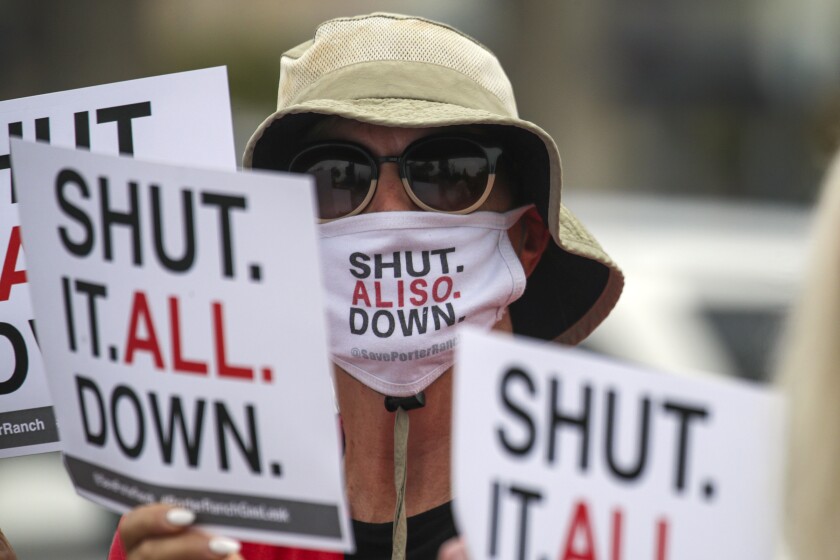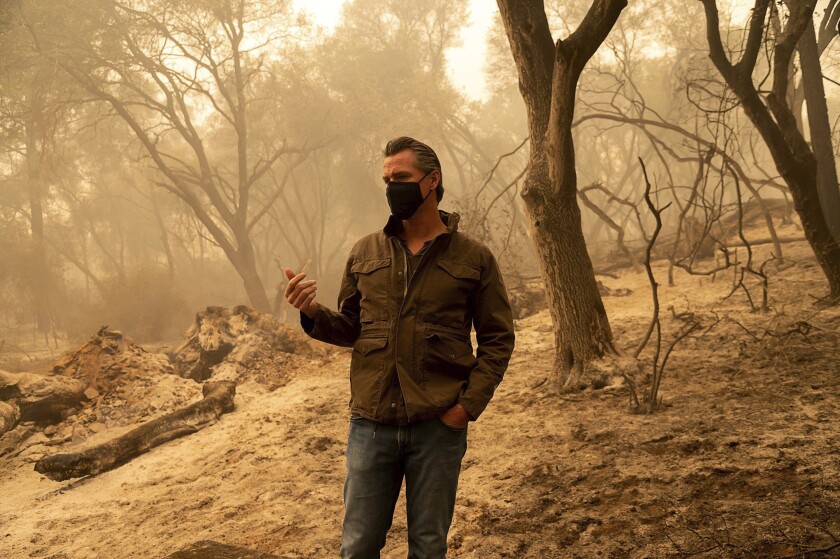One of the difficult things about being a journalist is learning to accept that few stories ever truly end. Yes, maybe there's resolution of some kind, but the deeper issues don't go away. The health effects of a fire linger. The problem that legislation was meant to solve only gets worse. You move on to other stories, but you can never really let go of the stuff that came before.
That's certainly the case for Aliso Canyon.
It's been nearly six years since the gas storage field sprang a massive leak, spewing more than 100,000 tons of planet-warming methane and other chemicals into the air breathed by residents of Los Angeles' Porter Ranch neighborhood, in the San Fernando Valley, over the course of four months. About 8,000 families fled their homes, many reporting headaches, nosebleeds and nausea.
Those families got a measure of closure this week when Southern California Gas Co. — which owns Aliso Canyon and is the country's largest natural gas utility — announced legal settlement agreements that could collectively pay out $1.8 billion.
My colleagues Gregory Yee, Tony Barboza and Leila Miller wrote about the settlements, explaining that arbitrators will now analyze the cases of more than 35,000 people to determine how the methane blowout affected them, then begin distributing the money.
But that's far from the end of the story. The big question now — one of the big questions, anyway — is whether Aliso Canyon ought to be shut down, both to protect the health of nearby residents and to propel California's transition to energy sources that don't cause climate change.

An infrared image shows methane gas leaking from the Aliso Canyon storage field. (AFP Photo / Environmental Defense Fund)
Gov. Gavin Newsom once said he wanted to "fast track" the shutdown of Aliso Canyon. In November 2019, he wrote to Marybel Batjer, president of the California Public Utilities Commission, asking her to "expedite planning" for the facility's closure.
I reported last summer that climate activists were nevertheless frustrated by the commission's slow pace. Fifteen months later, they're still frustrated. It's now been 5½ years since the commission began studying the feasibility of shutting down Aliso or minimizing its use — as ordered by state law — and it's still far from clear when the agency might reach a decision.
Alexandra Nagy, California director of the environmental group Food and Water Watch, says Newsom must step up.
"There's a lot more work that needs to be done, and a lot more leadership that needs to be shown," she told me.
Newsom's November 2019 letter did have some effect: The next month, the Public Utilities Commission opened a new phase in its long-running study, promising to finally examine what combination of clean energy technologies might replace Aliso.
Still, a modeling report released by commission staff this past January assumed that peak winter gas demand would fall by just 3% over the next decade — and peak summer demand would rise by nearly 5%. That's despite a state law mandating 60% renewable electricity by 2030, and a number of state and local efforts to transition households from gas furnaces to electric heat pumps.
Climate activists see the commission's projections as out of whack with reality.
"We need to figure out a way to transition away from natural gas," said Tyson Siegele, an energy analyst at the Protect Our Communities Foundation, a San Diego-area environmental group. "It's not going to happen today. It's not going to happen tomorrow. But if we don't start heading in that direction today or tomorrow, we're never going to get there."

Activists push for the shutdown of Aliso Canyon at Tuesday's rally and news conference in Porter Ranch. (Irfan Khan / Los Angeles Times)
State Sen. Henry Stern, a Democrat whose district includes Porter Ranch, has slammed the Public Utilities Commission for not working harder to accelerate that transition. In a blistering letter to Batjer in March, he questioned the commission's projections of future gas consumption, saying it appears the agency "does not want to engage in a strategy to significantly reduce gas demand in Southern California, even though California's clean energy and climate targets depend on phasing out combustion."
The commission has defended its analysis. Spokesperson Terrie Prosper told me earlier this year that the agency's gas demand projections were "based on the current gas and electric infrastructure, California's current climate policies, and the current assumptions about future electricity procurement." The next phase of the analysis, she said, "is evaluating additional portfolios of investments beyond what is already planned or authorized that could allow Aliso Canyon to be closed by either 2027 or 2035."
"Part of the CPUC's mission is to ensure energy reliability for Californians," she said in a written statement.
SoCalGas has focused on the reliability argument, saying Aliso is key to supplying the natural gas-fired power plants that keep the region's air conditioners running during the summer, as well as the furnaces that keep homes warm during the winter.
Gas company spokesperson Christine Detz said in an email that experts and utilities commission staff "have consistently recognized that Aliso Canyon continues to play a vital role in the resiliency of California's energy system, and supports the continued decarbonization of electricity by flexibly working to balance the peaks and valleys of solar and wind supply."
"In the last two years, Aliso Canyon has provided support to the region's electric and gas systems on more than 150 days. Use of this facility has kept energy prices stable and helped prevent outages during periods of peak energy demand," she said.
It's worth noting that the gas company — a subsidiary of San Diego-based Sempra Energy — has a financial incentive to keep Aliso open. The facility had a net book value of $821 million at the end of 2020, per Sempra's financial filings, and as long as it remains in operation, SoCalGas customers will ultimately be on the hook to pay off the company's investment, plus shareholder profits.
Another nuance to consider: The gas company also operates several smaller storage fields, including one in Playa del Rey that has a long history of leaks and could cause far greater health and economic damage than Aliso if it suffered a major blowout, as I reported in April. Aliso's closure could bolster the company's case for keeping those fields open, or even increasing their use.

A hub for Southern California Gas Co. infrastructure at the company's storage facility in Playa del Rey, with the Ballona Wetlands in the background. (Mel Melcon / Los Angeles Times)
I asked Najmedin Meshkati — a University of Southern California engineering professor who has studied the methane blowout and criticized what he sees as the poor safety culture at SoCalGas — whether Aliso should be shut down. He pointed to the possibility that doing so would just create more risk at gas fields in Playa del Rey, Santa Clarita and Santa Barbara County.
"We have a need for natural gas in Southern California," Meshkati said. "We'll have other underground gas storage facilities for the foreseeable future, until we say we're shutting down all the natural gas consumption."
Again, California is working on that — but too slowly, clean energy advocates say.
Stern, for instance, wrote a bill, signed into law in 2018, that set aside $200 million to incentivize all-electric buildings and jump-start the market for electric space and water heaters. But when he and I spoke earlier this year, he told me not "a single cent" had been spent as the Public Utilities Commission and the California Energy Commission slowly worked out the details.
"If you swapped out everyone's broken furnace and gas heater in L.A., not only could you close Aliso, you could probably close Playa, and save people a lot of money," Stern said.
Prosper told me this week the Energy Commission is still developing guidelines for one of the initiatives funded by Stern's bill, known as the BUILD Program. The other initiative, TECH Clean California, should start distributing funds in the next few months.
Where does Newsom stand on phasing out the gas system? When I asked the governor's office earlier this year whether the utilities commission is moving too slowly on Aliso — and whether the governor supports calls to close Playa del Rey — Newsom spokesperson Erin Mellon didn't answer directly. She said in an email the governor's administration "is actively working to get to a carbon-neutral economy by 2045 and believes the need for natural gas storage may look very different in that future."
I checked in with Mellon this week to see if anything has changed, and she had nothing new to add. But the story is far from over.
For now, here's what else is happening around the West:
ADVERTISEMENT BY Southern California Edison
Making EV charging more convenient means we can all breathe easierAs more and more Californians choose zero-emission transportation, it's important for them to have access to electric vehicle charging wherever they live, work, shop and play. That's why over the next few years, Southern California Edison will be working with businesses, local governments and other organizations to add 38,000 new electric car chargers in the communities we serve. SCE remains committed to working with our 15 million customers to create a clean energy future.
End of advertisement
|
|
DROUGHT CENTRAL
California's Imperial Irrigation District, which uses more Colorado River water than anyone else in the West, has settled at least some of its differences with the L.A.-based Metropolitan Water District. The legal settlement could ease the way for greater water conservation as climate change saps the river's flow, my colleague Ian James reports — which is especially crucial in light of new projections showing a one-in-three chance that Lake Powell will fall so low by 2023 that Glen Canyon Dam will stop being able to generate electricity, depriving the region of a cheap, climate-friendly power source. More details here from Ian.
Why is the Western drought so bad? Hardly any rainfall is part of it, but a hotter, thirstier atmosphere is just as important, The Times' Paul Duginski writes. If you're wondering why cities don't just draw more water from underground, Rachel Schnalzer explains that Los Angeles does, in fact, depend on groundwater for about 10% of its supply, and is making plans to recycle more wastewater and store it in underground aquifers. And if for whatever reason you think you're better off drinking bottled water, don't forget that it's usually just bottled tap water, sold at an astronomical markup, as columnist David Lazarus reminds us.
A remote desert town could have its water supply cut off if a mining company won't comply with California's groundwater sustainability law. For decades, Trona has depended on Searles Valley Minerals for its drinking water. But the company is being ordered to pay $30 million to help the region comply with the 2014 Sustainable Groundwater Management Act, and rather than cough up the money Searles Valley Minerals is suing, arguing the fee is draconian, The Times' Thomas Curwen writes.
THE WEST ON FIRE

The Stagg Tree, a giant sequoia in the Alder Creek Grove. (Brian van der Brug / Los Angeles Times)
"I don't feel hopeful, but we can't give up. There's too many of us deeply invested. The Sierra will be a chaparral field before anyone stops trying." That's what one fire ecologist told my colleague Diana Marcum, who wrote a beautiful story about the scientists trying to save California's Ancient Ones, its giant sequoias. They've got their work cut out for them, between an ever-more fire-prone climate (with hotter nighttime air); ignitions caused by humans (such as the woman accused of starting the Fawn fire); and ignitions caused by utilities (most notably Pacific Gas & Electric, which was just charged with manslaughter for its role in last year's Zogg fire). It's now also Santa Ana wind season, as The Times' Patt Morrison reminds us in her trademark poetic style.
In the Sacramento suburbs, residents are worried that more campsites planned for an already-crowded state park would increase fire risk and make it harder to evacuate in an emergency. State park officials, though, say the campsites are needed to manage inevitable overcrowding and the risks would be worse without them, Hailey Branson-Potts reports for The Times. And speaking of fires and public lands, hikers are facing a future of frequent forest closures as the planet warms, Lila Seidman writes.
As goes California, so goes the nation — and as California burns, so breathes the nation. That's my takeaway from this analysis by NPR's California Newsroom, which found "a startling increase in the number of days residents are breathing smoke across California and the Pacific Northwest, to Denver and Salt Lake City in the Rocky Mountains and rural Kentucky and West Virginia." Meanwhile, heavy smoke prompted an air advisory in Southern California this week. Here's how to keep your lungs safe.
In better news, firefighters managed to stop the Dixie fire from becoming California's second million-acre blaze in modern history. There's a lot to be learned from which strategies worked and which didn't, my colleague Hayley Smith writes.
POLITICAL CLIMATE

Gov. Gavin Newsom tours the North Complex fire zone in Butte County on Sept. 11, 2020. (Paul Kitagaki Jr. / The Sacramento Bee via AP)
Gov. Gavin Newsom signed into law a $15-billion climate package, the largest such investment in state history. It includes $5.2 billion for drought response and water resilience, $3.7 billion for issues like extreme heat and sea level rise, $3.9 billion for electric vehicles, $1.5 billion for wildfire response and forest resilience, and $1.1 billion for sustainable agriculture, Hayley Smith and Tony Barboza report for The Times. Newsom will face another key climate decision soon: whom to appoint as president of the state's Public Utilities Commission, following Marybel Batjer's announcement that she will step down at the end of this year.
A judge ordered the Interior Department to reevaluate its decision not to protect Joshua trees under the Endangered Species Act, writing that officials ignored the threat posed by climate change. Here's the story from the Desert Sun's Janet Wilson, who notes that the Biden administration has followed the Trump administration's lead in not safeguarding Joshua trees.
Far-right militia groups and politicians are harassing and intimidating public health officers in towns across the West, sowing the seeds for decades of public health crises, Jane C. Hu reports for High Country News. It's a powerful, important story with a strong public lands nexus, since some of the danger has been fueled by antigovernment militant Ammon Bundy.
PROMOTION
THE ENERGY TRANSITION
Southern California Edison and PG&E customers, prepare to be switched to electric rates that change with the time of day. This is probably good for climate, Times columnist David Lazarus writes, because it could encourage people to shift their electricity use to times of day when solar and wind power are abundant. But Edison needs to do a far better job communicating the change with people who could see their energy bills rise if they don't shift their behavior or opt out of time-of-use rates, David writes.
Another Times columnist, Michael Hiltzik, is not persuaded that renewable natural gas is a viable substitute for the vast majority of fossil gas burned today. In his latest column, he comes down hard on the fossil fuel industry, writing, "What's really driving the campaign to make natural gas look green is the desperation of companies such as Chevron and SoCalGas to turn a blind eye to consequences of global warming." See also my story from last year on the pluses and minuses of renewable gas.
The world's largest independent PR firm has been secretly working for Exxon Mobil. Edelman's work for the oil and gas giant was revealed last week by the Clean Creatives campaign, as Dharna Noor chronicles for Earther. Clean Creatives co-founder Jamie Henn likened the PR firm's response — "We do not talk about any opposition to climate legislation and our work is to do with job creation, economic opportunity and land access" — to "having Darth Vader as a client but pretending you aren't on the dark side."
ONE MORE THING

Jack Ryan Greener summits Mt. Whitney. (Chase Viken)
Let's end on a hopeful note. My colleague Mary Forgione told the incredible story of Jack Ryan Greener, age 26, who responded to a potentially debilitating spinal cord injury by teaching himself to walk again and then gritting his way up Mt. Whitney.
"I just wanted to show kids with a spinal cord injury or cancer or anything," he said on his way down the mountain, surrounded by the friends who helped him up Whitney. "You can go do these insane things you never thought were possible."
We'll be back in your inbox next week. If you enjoyed this newsletter, please consider forwarding it to your friends and colleagues.
No comments:
Post a Comment